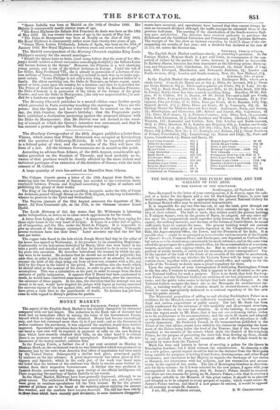THE ROYAL RESIDENCE, THE PUBLIC RECORDS, AND THE GALLERY OF
FINE ARTS.
TO THE EDITOR OF THE SPECTATOR.
Southampton, 3d September 1846.
SIR—In regard to the letter of your correspondent, J. R. Gowen, upon the sub- ject of a house for the Queen and a use for Buckingham Palace, in your last week's number, the suggestion of appropriating the present National Gallery for a National Record-office may be pronounced impracticable. It is impossible for any one who has not, to say the least, gone through our public record-offices, and seen the space which their contents occupy, to form an idea of their volume. The bulk is such, that neither could the present building in Trafalgar Square, even by the genies of Barry, be adapted. nor any other edi- fice upon the comparatively small superfice lying between the North side of the square, the military barracks, and the lane at the bottom of Castle Street, be raised sufficiently large to contain the mass. The present building would not contain one-fifth of the united piles of records deposited in the Chapterhouse, Carlton Ride, the Augmentation Office, the Tower, and the Precincts of the Rolls. It. is possible that it might be so arranged as to receive the various records of the Courts of Queen's Bench, Common Pleas, and Exchequer, now deposited at Carlton Ride; but not so as to be stored away conveniently for ready reference, and at the same time afford the proper space for a public record-office, for the accommodation of searchers, keepers, assistants. and copying-clerks, &e. But to render it only a partial re- pository of public records, is surely not the meaning of your correspondent.? Un- til the amount of the bulk of the whole of the records of the realm be ascertained, it will be impossible to say whether the Victoria Tower will be large enough to contain them, together with a suitable public record-office, and equally so for the Lords of the Treasury to decide upon a grand repository for them. Upon the suggestion of your correspondent of dedicating Buckingham Palace to the fine arts, I venture to remark, that it appears to be as ill-suited as the pre- sent National Gallery for such a purpose. There is no doubt that both Buck ing- ham Palace and the National Gallery are emblems of our bad judgment and worse taste; and the public voice seems to declare that both must be changed. As the National Gallery occupies the finest site in the Metropolis for architectural dis- play, a building worthy of the situation should be erected thereon; such a pile would be more appropriately dedicated to a national repository of the tine arts than the public records. The Ministerial proposition of adding to and altering Buckingham Palace as a residence for the Monarch cannot be sufficiently condemned, as involving a pro- digal and useless expenditure of public money. The late Mr. Nash has been justly condemned for the existence of this unsightly and ill-arranged structure, and for the choice of its very bad situation. As to the building, we may gather from the report made by Mr. Blore, that it has not one redeeming virtue, either as to its architecture or its accommodation; and the site is ill chosen and adapted as regards drainage, access, and salubrity; any one of which objections is suffi- ciently damnatory. Sir Frederick Trench, in his memorandum published in the Times of the 31st ultimo, might have added to the statement respecting the base- ment of the Palace being below the level of the Thames, that if the heavy tlaps attached to the mouths of the sewers which drain the district of Buskin ham Palace, for the purpose of preventing the river-tide from flowing up them, should by any accident not be closed, the basement offices of the Palace would be in- undated by water from the Thames ! Much has been said latterly in favour of erecting a palace for the Queen in Kensington Gardens; but I think without due consideration. In choosing a site for a new palace, special regard should be had to the distance from the Metropolis being suitable for purposes of holding Court levees, drawingrooms, and other goyal ceremonies, and convenient to her Majesty as regards the discharge of her duties as Monarch, her intercourse with her subjects, and her recreations and amuse- ments in the capital of her realm. The site of Kensington Gardens is objection- able for these reasons: for if it were selected for the new palace, I agree with your correspondent in his 6th proposal, that St. James's Palace should be retained. But there are two reasons for giving up St. James's Palace,—viz. that in erecting a new palace suitable to the Monarch of this great nation, it should be so planned and situated as to be adapted to every purpose of royalty, which would render St. James's Palace useless; and that if a new palace be erected, it would be opposed to all economy to retain St. James's.


























 Previous page
Previous page